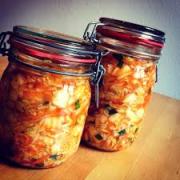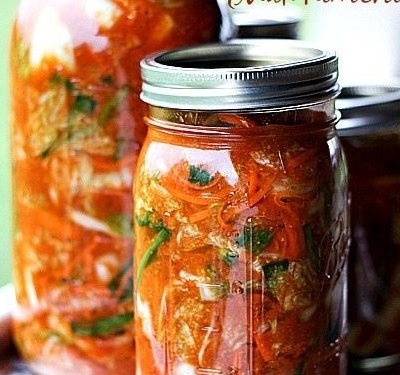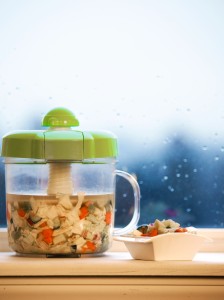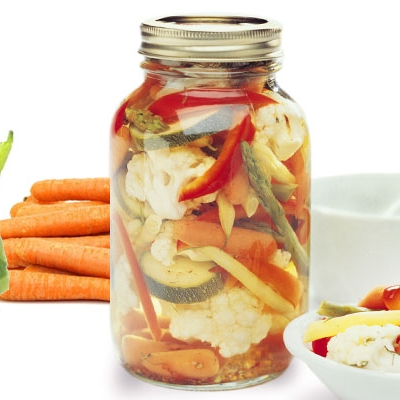Kimchi Recipe. Regular Mixed Pickles Variation
Kimchi

They are a probiotic nutritional treasure, in addition to being a delicious low calorie treat, and are a snap to make. A Korean staple. From salads to sandwiches, or by themselves as a super healthy snack. I even make Kimchi Latkas! Pretty funky and pretty awesome.
Pickles and KimChi recipe, and much much more, are in my New Cookbook, The Whole Foods Kosher Kitchen.
Fermented Foods

We grew up eating pickles and all fermented foods: Not just what we in the US call pickles, but all things pickled: All vegetables, olives, lemons, apples, watermelon rind, butter, cheese, you name it. Pickles are not the only thing we grew up eating: Sun-dried meats and vegetables, preserves and jams. All homemade. There was always something brined, or fermented, or cured, or preserved on our kitchen counter. Our pickles are brined, but the kimchi is made with no liquid other the liquid formed by pressing the vegetables together.
Fermenting and Preserving
Since refrigeration came to us in Morocco relatively recently, only about sixty years ago, the delicious and healthy solution to food storage was fermenting and preserving, and we still carry on this treasured tradition, long after we acquired all our modern kitchen amenities.
You’ll love my Kimchi
They have a small fraction of the salt and the vinegar of their commercial counterparts, and ten times the flavor.
Crunchy and pungent with just a hint of sweetness, and really good for you too, like all fermented foods. I whip my Japanese pickles out anytime I need a quick fix but can’t afford anything too caloric. The simple secret here is to force the mixture into a wide-mouth glass jar or a pickle press (see below) so it disgorges its juices and you are left with a reduced and powerfully condensed bowl of pickles.
Scroll down for a regular brined pickles variation.
Kimchi ingredients
The following ingredient list is just a suggestion. Let me start by saying I avoid cucumbers and peppers, as they are too perishable for this mixture: they would good and crunchy for just a few days, whereas kimchi made with the ingredients below are nice and sturdy, and last you a good few weeks.
Mix and match some of your favorites: add to your selection cauliflower florets, nappa cabbage, red cabbage (if you dont mind the mixture turning red. Same for beets), jicama, kohlrabi, daikon, radishes, cut up string beans, red onion, even green apples and green tomatoes etc…. Same goes for seasonings. All suggestions are below.
Kimchi Press

This nifty, inexpensive round or square box is the secret of professional-tasting pickles and kimchi easily made in your own kitchen. Mine is 3½ quarts and is easy to order online. It is equipped with a vise that comes down on the seasoned vegetables you are pickling. Place your seasoned vegetables in the press, press down hard to lock the press, and turn the vise down as low as it will come. You will be amazed how the vise will compress the veggies, separating the liquids from the solids. After a couple hours, the pickles are ready: You are left with a fabulous handful of pickles. Transfer the pickles to a glass jar with only enough of the pickling liquid to cover them completely, discarding the rest of the liquids. Or simply leave them in the pickle press, liquid and all.
Regular Pickles

Scroll down for the regular brined recipe variation!
Ingredients
My favorite vegetable kimchi mix
Mix and match from the suggested ingredients above
- ½ head cauliflower, cut into small florets
- nice wedge nappa cabbage (about 1 pound), sliced thin
- 2 large carrots, sliced thin
- 1 medium purple onion, sliced thin
- 1 large turnip, cut in wedges, then sliced thin
- 6 ribs celery, peeled and sliced about 1/2 inch
- 1/2 pound string beans, cut into 1 inch segments
My favorite seasoning mix
- ½ cup brown rice vinegar, or unfiltered apple cider vinegar
- 1/4 cup sea salt
- 1/4 cup sugar
- 1/4 cup gochugaru or chili powder, less if you think your chili powder is too hot
- 3 inch piece ginger, minced
- optional: 5 large cloves garlic, sliced thin
Instructions
Place all the vegetables in a glass or stainless steel bowl.
All seasoning ingredients, and mix thoroughly with all the vegetables.
Force the mixture, pressing hard with your hands, into a two quart mason jar, or 2 1-quart mason jars (or in a pickle press: see instructions above). Pretty soon the vegetables will get covered with their own juices. Make sure there is no air space left in the jar, fill all the way up.
Leave the jars out 5-6 days, then store refrigerated. It will last you a good few weeks.
Yields about 2 quarts, and maybe 1 pint jar.
For Regular Brined Pickles:
This is the way we eat them in Morocco. No forcing the vegetables down. Place all ingredients in a large jar, add your favorite spices in a small cheesecloth bag securely tied (peppercorns, coriander seeds, cumin seeds, garlic slices etc), 2-3 teaspoons turmeric powder if desired, include 4-5 sliced jalapeños if you like it spicy.
Add 1/2 cup cider vinegar, 1/4 cup salt, and water to cover
Shake vigorously to combine. Allow 5-6 days to pickle at room temperature, then store in the refrigerator.




please where can i find this pickle press! thank you
Phyllis I bought it online, on amazon I am pretty sure
Will this recipe work without the sugar?
We no longer eat refined sugar.
Lori I don’t use refined sugar either. Use the unrefined sugar if your choice.